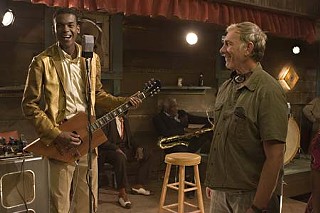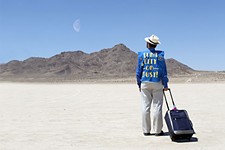John Sayles
The evolution of American music and Southern race relations in "Honeydripper"
By Melanie Haupt, Fri., Feb. 1, 2008

John Sayles on the fates of and stakes for musicians when faced with that seismic moment in musical history, the advent of rock & roll: "What about the people who didn't want to jump aboard, didn't especially like that music, or felt they were too old to be accepted playing that music? And what happened to the people who just couldn't do it for whatever reason? And what about the people who did? What did they do with it? The interesting people are those who don't necessarily create something from whole cloth, but they take little pieces of this, that, and the other thing and make something with it."
And that's how another signature Sayles film came into being. Taking bits and pieces from here and there and making magic.
Over the course of three decades and 16 feature films, Sayles has established himself as one of cinema's most intelligent, passionate, and engaged filmmakers. His oeuvre reveals critical engagement with labor struggles (Matewan), the Texas-Mexico border (Lone Star), international adoption (Casa de los Babys), and American politics (Silver City). Each of Sayles' films is intricately layered, requiring multiple viewings in order to appreciate fully the nuanced observations of class, race, gender, and language within his carefully constructed, finely drawn worlds. In his newest film, Honeydripper, music is the mechanism with which Sayles enacts his iconic interrogation of our culture, with both the evolution of American music and race relations in the South in his sights.
Honeydripper is set in 1950 in Harmony, Ala. Tyrone "Pinetop" Purvis (played by Danny Glover) is the owner of an ailing nightclub (the titular Honeydripper). Purvis is slowly being run out of business by the joint across the street, Ace of Spades, which lures the crowds with a shiny, new jukebox. In hock to the liquor man, the chicken man, and the electric company, Purvis grasps desperately at the opportunity to save his operation and sees his chance in the mysterious young drifter (Austin's own Gary Clark Jr., in his acting debut) who shows up in Harmony with a homemade electric guitar. Over the course of the story, Sayles not only provides a glimpse of the crossroads of American music but also of the burgeoning civil rights movement, all told from the perspective of a troubled black business owner struggling to maintain his grip on his life and set to an electrifying soundtrack.
Music – the way it is written, performed, and delivered – is always changing and always aided by technology. In only about a hundred years, we have gone from spreading music (and, by extension, our stories of ourselves) via the oral tradition to having the ability to listen to music streamed from all points through our computers. As a result of this local-gone-global phenomenon, there are several iterations of the inception of rock & roll floating around within the cultural consciousness: Elvis and that hypnotic pelvis, the British Invasion, Bob Dylan plugging in at the Newport Folk Festival. According to Sayles (and others), rock & roll was born in the Deep South and husbanded by practitioners of blues and swing; he points to two major shifts in the consumption of music in our country's history as the inspiration for Honeydripper.
"One was when radio came in, and that didn't really happen until after 1920. And that was a big deal; [you were hearing] all kinds of music you've never seen or heard," Sayles says. "All of a sudden you're not stuck in a holler in West Virginia; you're starting to hear people. Music started moving a little faster, fusing a little quicker. One of the next big [shifts] was when the solid-body electric guitar and the amp that goes with it showed up in 1950. That technological change meant that in about five years the guitar player stepped out in front of the piano and said, 'Hey, I'm the lead instrument now.'"
Clark, whose hungry, young drifter embodies the musical shift at the center of Honeydripper's narrative, agrees that Sayles has captured a critical cusp in our country's social and cultural history. "I think the Fifties and Sixties are crucial because African-Americans started to stand up and rebel against injustice and express themselves. This progression was expressed in music on a wide platform, and someone decided to call it rock & roll. The pot was just stirred up a bit, and some beautiful music came out of it."
The mise-en-scène of a Sayles film goes far beyond the precise placement of a liquor service or the way a cafe wall is painted in a South Texas border town. The devil is beyond the details in these cinematic worlds; he's in the DNA. "For us, one of the big deals was the guitar, because Gary's character was supposed to have made his own guitar," Sayles explains. "We found a luthier and gave him the era and told him that this kid was a radio repairman, and he's going to make his own from a magazine article or something, and like most people, he's gonna cannibalize an acoustic. And he's not a great carpenter, so it's a pretty simple geometric thing."
The resulting instrument, crafted by New Jersey-based luthier Ted Crocker, is a solid block of mahogany designed to look like it was built by a World War II-era radio operator, complete with three exposed two-string pickups. It is a crude-looking piece of outsider art, but it plays beautifully, as exhibited by Clark when he performs live in the movie rather than pretending to play to a prerecorded guide track. (Interested parties can procure a custom version of the Honeydripper guitar via Crocker's website, www.tedcrocker.com, for $5,150.)
"It was the heaviest guitar I've ever picked up [or] played," says Clark. "I enjoyed playing it because of the simplicity. It is the electric guitar in its rawest form! No pretty paint, superfancy knobs, or pickups." In some ways, it appears that the primitive look and feel of the guitar helped Clark to inhabit his character. "I think back then the mentality was, well, it works, and that's all that matters. I tried not to compare it to my guitars and just go with it. That's what Sonny would have done."
This devotion to creating the most authentic world possible extends beyond the narrative's crucial prop. Maggie Renzi, Sayles' longtime production and domestic partner, describes the process of piecing together the microcosm of Harmony, Ala. "Once John's written the script and by the time we come to a location, we're starting to get more information from more people," she says. "For example, the art department started looking for cars, and they said that there wouldn't have been any personal cars any more recent than 1942 because of World War II. And this is rural; there are not very many upper-middle-class people, so there would be mostly work vehicles."
And, as evidenced by the character of Miss Nadine (Davenia McFadden), the women in 1950 rural Alabama were wizards with the sewing machine. "Hope Hanafin, our costume designer, explained that the clothes would be high fashion but wouldn't be off the rack," Renzi continues. "These women would know how to make them; they'd know what the fashion was and scratch together whatever fashion they needed to and make something up for Saturday night, because it was a stiff competition."
Attention to detail to such microscopic levels aids everyone from the moviegoer to the actors on the set. "It helps the audience feel like they've entered a world that's not quite the world we live in today," says Sayles. "If you do it well enough, they kind of forget that it's a movie and that people made these decisions. And I also think it helps the actors. There are a lot of actors that just can't wait to get their hands on the props or can't wait to get their clothes on. The car that they're driving really does it for them, and they say, 'Okay, I know who I am now; I know where I am.'"
For Clark, who has logged many years on the clubs and stages of Austin, the scope of Sayles' knowledge helped ease him into the alien world of acting. "I just like hanging out with John. He knows so much about everything. He would get into these conversations from politics to bird-mating habits to old basketball stats to Big Mama Thornton. I was amazed and drawn to him. He's a huge fountain of knowledge, and I just try to soak up as much as possible. With that, I found it easy to trust him as director because he has done his research and knows what he's talking about."
Sayles' attention to detail and the depth and breadth of the research that goes into crafting such a narrative quite possibly set the viewer up to miss truly rich sociocultural references, if they're not paying attention. Stephen Holden, writing for The New York Times, says, "[Sayles] is so uncomfortable writing dialogue in an old-time Southern argot that the conversations in Honeydripper rarely settle into the easy, colorfully idiomatic flow that has always been a hallmark of Southern speech." However, if Holden weren't so occupied by what he perceives as a missed opportunity to sustain stereotypical representations of "Southern" (read: black) speech, he might have picked up on a striking reference to a prominent hero myth of African-American culture.
The folktale of Stagolee dates back to the late 19th century, when St. Louis cabdriver Lee Shelton shot a man in a barroom brawl in a conflict over a hat. The 1895 event was immortalized in blues and has been handed down in blues, folk, funk, and rock music (most notably by Mississippi John Hurt, but also Bob Dylan, Woody Guthrie, Ike Turner, the Isley Brothers, and Nick Cave & the Bad Seeds) and toast poems and is often credited as the inspirational figure of gangsta rap. In short, Stagolee is a badass black man, expert at doing the dozens, and caring little for the white man's rules. In The Afrocentric Idea, Molefi Asante, the pre-eminent scholar in African studies, writes, "Stagolee represents the radical impulse to challenge an authority that seeks to repress freedom, improvisation, and harmony."
Sayles alludes to the Stagolee myth via Pinetop Purvis, from the flashbacks to his near-mortal conflict with the guitarist in his own past to the oracle Possum's (Keb' Mo') version of the blues song. Even though he resists the narrative of Stagolee when Possum serenades him with it, brushing it off with, "I hate that song," Purvis himself is a reluctant Stagolee, invoking what Asante terms the rhetoric of resistance. "Tyrone is a guy who has a certain status as the guy who runs this club," explains Sayles. "He's not fighting to save that building, he could rent another building. He's an African-American man in the Deep South in 1950 who's his own man, and that's what he's fighting to save. He's fighting for that position. Somehow he senses that it's important not just to him but also that it's important to his community that there is someone like him and Maceo [Charles S. Dutton] who are outside the white people's sphere and seem to be their own men."
Clark sees a morality tale of sorts in Sayles' portrayal of the myth. "I thought that the parallels between the myth and Tyrone Purvis and Possum were brilliant," he says. "Ego, pride, denial, and acceptance are a huge factor in society and the way we go about our everyday lives. I thought it was really eye-opening how John subtly depicts this in the way Tyrone and Possum interact."
With this gesture toward the archetype, Sayles himself participates in the same fluidity of music he documents in Honeydripper, enacting the same forward- and backward-looking protean ethos of American music, from the outdated juke-joint blues of Bertha Mae (played by Mable John, former backup singer for Ray Charles and sister to R&B star Little Willie John) to the squalling birth of rock & roll, bursting into the world with the glint of rap in its eye. Boundaries and labels be damned.
A common trope among Sayles' scripts is the idea of a border, a line of demarcation. On either side of these arbitrarily drawn lines are characters whose arcs rely upon a realization (ours and theirs) that the lines are indeed arbitrary and that life itself is colored primarily in varying shades of gray. For example, Buddy Deeds (Matthew McConaughey), the sainted sheriff in Lone Star, is set in stark opposition to the vicious, murdering Charlie Wade (Kris Kristofferson), yet both men are corrupt to the core. In putting moral absolutes in conversation with each other, Sayles troubles the arbitrary binaries of the everyday, revealing them as simply rhetorical inventions rather than concrete realities.
"I'm always interested in what are the things that we allow to separate us. In the case of segregation in the South, those laws didn't exist unless somebody was going to cross the line," he says. "Laws in the South, if you read history, got more repressive because people transgressed them. All those Jim Crow laws came from someplace, which was that white and black people were getting together. That's always interesting to me, those people that figure out that [a particular] law is bullshit and even at some risk [will] cross it."
Take, for example, Purvis, who lies, cheats, and steals yet remains sympathetic through the course of the movie. Meanwhile, a Pentecostal preacher has the ear of Purvis' wife, Delilah (Lisa Gay Hamilton), instructing her that she's either with God or with the devil; ain't no in-between. Delilah's arc is complete when she realizes that where the Lord is telling her to be is by Tyrone's side. Delilah can still come back to the church, but she realizes that sometimes in between – at Tyrone's side at the Honeydripper – is where the Lord wants her to be, and she can move gracefully between those two worlds.
White/black, rich/poor, male/female. These are some of the binaries Sayles explores in Honeydripper, deconstructing them and exposing the hierarchies within and among them. Such complexity makes for masterful filmmaking, albeit with somewhat limited appeal. In a cinematic landscape inundated with torture porn, million-dollar explosions, rubbery fat suits, and dim-witted rom-coms, a John Sayles film is a rare treasure: quiet, intelligent, challenging, and rooted in a deep love of a deeply flawed culture. Sayles' appreciation for the subtleties of gray is, in a way, both absolution and celebration, and Honeydripper beautifully encapsulates those extremes.
Honeydripper opens in Austin on Friday, Feb. 1. See Film Listing for showtimes and review.













